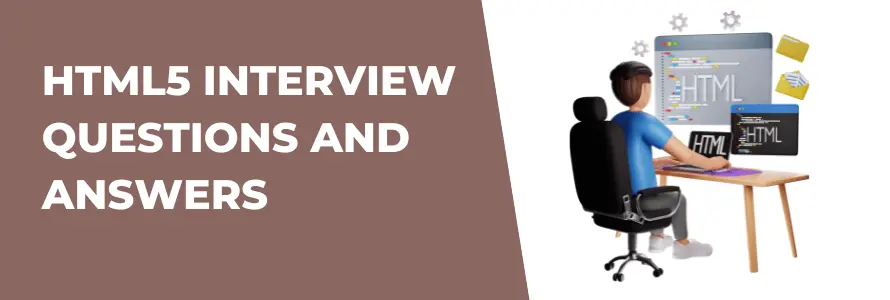HTML5 Interview Questions and Answers

In the past years, the adoption of HTML5 has increased in an emerging way that more and more companies are using it to deliver rich cross-platform web applications. In this article, we have tried to cover all HTML5 Interview Questions and Answers which are for both basic and advanced levels. Now the question that would come to your mind is- what is HTML5? To develop any web application mainly three components are required i.e. HTML, CSS, and Javascript where HTML is mainly used for designing the website.HTML5 is the latest version which supports all kinds of existing web pages. Every web page you visit today on the internet is written with one or another version of HTML code. HTML5 is one of the highest-paying web technologies so everyone needs to learn basic concepts about this markup language. Companies like Facebook, Amazon, Google, and Youtube have been shifted to HTML5 from Adobe’s Flash for better development. For many years, millions of developers were using this technology but since 2015 it is the most reliable and universal choice to develop web applications. To help you with the same, we have created this article which would clear all your concepts regarding HTML5.
| Quick Facts About HTML5 | |
|---|---|
| What is HTML5? | It is a MARKUP language that is mainly used for creating interfaces rather than analytical works or logical. |
| What is the latest version of HTML5? | HTML5.2 released on December 2017 |
| Who developed HTML5? | WHATWG |
| When was HTML5 first released? | 28 October 2014 |
Most Frequently Asked HTML5 Interview Questions
The abbreviation WHATWG stands for Web Hypertext Application Technology Working Group in HTML5. This is an organization which both develops and maintains the HTML and API for web applications.
Microdata is a newly introduced, simple semantic syntax which can be used by developers to add the nested groups of name and value pair of data to documents, that are based on the page content commonly. It’s used with new global attributes of HTML5.
The in HTML5 refers to indicating to the web browser about the version of HTML in which the page is created. Neither there is an end tag is not is it case sensitive.
In HTML5, declaration should be the first thing before HTML tag. This is because of all previous version before HTML5 followed Standard Generalized Markup Language (SGML). Because HTML5 does not follow SGML, it does not require references to DTD (Document Type Definition).
HTML5 has introduced a way to let designers take charge of the web page area that is visible to the users through tags. The tag tells information related to an HTML document. Some of the examples are Link, Style, and Title. With meta tag, we can add meta ketwords, meta description and meta title that helps for SEO Purposes.
HTML5 has introduced new input types for forms. Designers can build interactive and user-friendly web forms by using these input types. The new input types also provide improved data validation, better color picker controls, and enhanced input control.
The new input types are:
- Time
- Date
- Datetime
- Datetime-local
- Week
- Month
- Color
- Number
- Range
- Search
- Telephone
- URL
A hyperlink in HTML is a text of an image on a web page that when clicked by the user redirects him to a new web page. Hyperlinks, or links, are defined with <a> tag. The primary use of Hyperlinks is to link one web page to another.
Yes. Both <header> and <footer> tags are made to fulfill their respective purposes in relation to their parent “section”. So not only can you use both header and footer elements on a page in HTML5, but you can also use both in every <article> or <section>. A <header> tag must be present for all articles, sections, and pages, although a <footer> tag is not necessary.
Our HTML5 interview questions are an ideal resource to prepare you for HTML developer job interviews.
The Geolocation API in HTML5 allows the users to share their physical location with selected websites. This happens when JavaScript captures a user’s latitude and longitude and sends it to the back-end server for enabling location-aware features such as finding local businesses or showing location on a map.
- Editing content within element and "required" form attribute
- Figure tag and SVG element
- Webfonts
- Transition and Animation
- Web Icons
- Easily implemented audio, video, map with these tags
No. Local storage is not very secure because it was not designed to be used as secured storage in a web browser. Local storage was only designed to be a simple key/value storage that developers would use to build single page apps.
Today HTML is considered as the base for all web applications, but with each passing version, many new elements and features have been added to it. So, there is a high chance that the interviewer may ask about the currently used features but as it all starts with HTML so one must learn both. To summarize-
- Should know the difference between versions of HTML especially HTML4 and HTML5
- When writing code, always close your HTML tags.
- Remember HTML is a Markup language, not a programming language.
- Work with the lists and be more familiar with HTML tables.
Features of HTML5
- Editing content within element and "required" form attribute
- Figure tag and SVG element
- Web fonts
- Transition and Animation
- Web Icons
- Easily implemented audio, video, map with these tags